The artificial intelligence in healthcare market is valued at USD 17.2 billion in 2025 and is projected to reach USD 77.2 billion by 2035, expanding at a strong CAGR of 16.2%. Among major regions, the United States leads the market, backed by deep-rooted AI research ecosystems and fast-paced regulatory approvals for AI-enabled medical devices.
On the other hand, India and China are poised to be the fastest-growing markets, with projected CAGRs of 17.6% and 17.1% respectively, driven by digital healthcare initiatives, rapid adoption of AI in diagnostics, and chronic disease management.
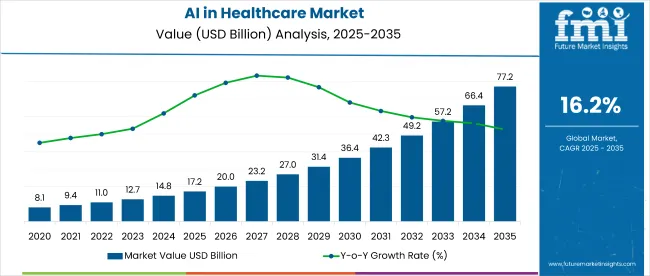
| Attributes | Key Insights |
|---|---|
| Estimated Size, 2025 | USD 17.2 billion |
| Projected Size, 2035 | USD 77.2 billion |
| Value-based CAGR (2025 to 2035) | 16.2% |
The market’s expansion is driven by rising demand for automation in healthcare, shortage of skilled professionals, and increased funding in AI startups. AI technologies such as machine learning, deep learning, and NLP are revolutionizing areas like robot-assisted surgeries, medical imaging, virtual health assistants, and drug discovery. Hardware remains the dominant segment, accounting for 60.2% of the market in 2025 due to the increasing need for powerful processing units to support AI algorithms.
Nevertheless, adoption faces hurdles due to integration challenges with legacy systems, unstructured data formats, and high upfront costs. These concerns are particularly pronounced in underfunded healthcare systems still reliant on outdated electronic health records (EHRs) and imaging platforms. Regulatory compliance and interoperability also add to the implementation complexity.
Between 2025 and 2035, the market is expected to enter a transformative phase. The convergence of AI with cloud computing, wearable devices, and telehealth platforms will enable hyper-personalized care, real-time monitoring, and AI-powered decision-making support. Investments in AI-powered diagnostics and smart hospitals will enhance clinical efficiency, while initiatives to digitize healthcare records and incentivize AI adoption will fuel global expansion. Future breakthroughs in generative AI, predictive analytics, and drug discovery pipelines will solidify AI’s role as a backbone of next-generation healthcare systems.
Hospitals are using AI to cut diagnostic errors, which is transforming the industry landscape. Algorithms trained on extensive imaging datasets are exceeding human accuracy in stroke detection, lung screening, and cardiac analysis.
In drug discovery, generative AI is used to create molecular structures, simulate interactions, and predict toxicity.
Microsoft is embedding AI through the Nuance platform. Voice recognition and ambient tools are improving documentation accuracy and physician decision support. AI is normalized within everyday care rather than added as a standalone system. Nvidia is reshaping life sciences with deep learning. Through BioNeMo on AWS, it enables analysis of genomics and proteomics data at scale. It is now seen as an infrastructure enabler for precision medicine, not just a chip provider.
Medtronic is building intelligence into surgical navigation and remote care systems, enhancing precision and continuity. DeepMind, through AlphaFold, is advancing AI from molecular biology into clinical diagnostics, driven by strategic partnerships.
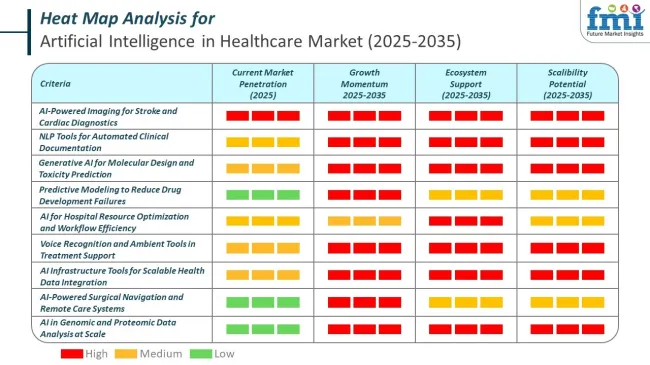
The below table presents the expected CAGR for the global artificial intelligence in healthcare market over several semi-annual periods spanning from 2024 to 2034. In the first half (H1) of the decade from 2024 to 2034, the business is predicted to surge at a CAGR of 19.2%, followed by a slightly lower growth rate of 18.8% in the second half (H2) of the same decade.
| Particular | Value CAGR |
|---|---|
| H1 (2024 to 2034) | 19.2% |
| H2 (2024 to 2034) | 18.8% |
| H1 (2025 to 2035) | 16.2% |
| H2 (2025 to 2035) | 17.7% |
Moving into the subsequent period, from H1 2025 to H2 2035, the CAGR is projected to decrease slightly to 16.2% in the first half and remain relatively moderate at 17.7% in the second half. In the first half (H1) the market witnessed a decrease of 100 BPS while in the second half (H2), the market witnessed a decrease of 110 BPS.
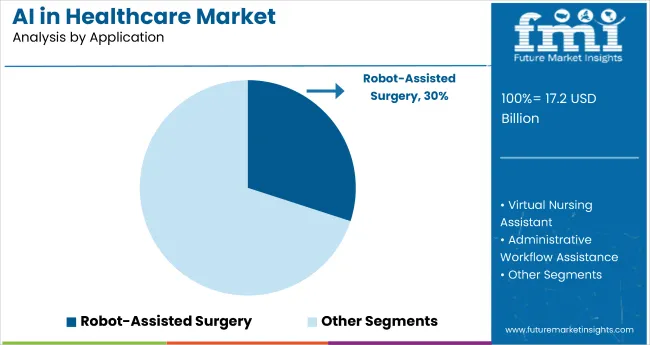
Robot-assisted surgery holds a leading position with 30% of the market share in the application category within the artificial intelligence in healthcare market. This dominance is driven by the rapid adoption of intelligent robotic systems that enhance surgical precision, minimize invasiveness, and improve patient outcomes in complex procedures.
AI-powered surgical robots offer real-time guidance, advanced imaging interpretation, and autonomous execution of targeted movements, resulting in reduced recovery times and lower complication rates.
Surgeons and hospitals are leveraging these technologies to expand minimally invasive surgery capabilities and boost operational efficiency. Continuous innovation in AI algorithms, sensor integration, and supportive analytics is further accelerating the adoption of robot-assisted platforms. As demand for advanced surgical care rises and healthcare institutions prioritize technology-enabled patient safety, the market share of this segment is expected to strengthen.

Healthcare providers dominate end-user adoption in the artificial intelligence in healthcare market, holding 60% of the overall market share. This leadership position is due to hospitals, clinics, and integrated care networks increasingly embracing AI solutions to optimize workflows, enhance diagnostic accuracy, and personalize patient care. Providers benefit from AI-powered technologies in areas such as medical imaging, patient monitoring, administrative automation, and predictive analytics, which collectively support improved clinical decision-making and resource management.
Widespread implementation of AI has enabled healthcare providers to address growing patient volumes, comply with value-based care directives, and respond efficiently to evolving disease burdens—including complex cases requiring fast data interrogation and multidisciplinary coordination. As the healthcare landscape advances toward data-driven, patient-centric care, provider organizations continue to drive the largest share of AI utilization in the industry.
Increased Investment in Healthcare AI Startups Drive Growth of Artificial Intelligence in Healthcare Market
The number of AI Startups have gone up and so has the investment. According to the World Economic Forum in the First 2 quarters of 2024 the total investment crossed the 35 billion dollar mark. For example, companies like Abridge have secured USD 150 million to develop ambient clinical documentation tools.
While AKASA raised USD 120 million to enhance revenue cycle automation. These investments are enhancing the operational efficiency of healthcare providers along with addressing critical challenges within healthcare industry.
Recent funding rounds for AI-driven healthcare startups highlight the growing interest wide range of healthcare applications from precision medicine to drug discovery. Zephyr AI is a precision medicine startup that raised USD 111 million in a Series A funding round on March 13, 2024. This round saw investments from major players like Eli Lilly & Co. and MedStar Health.
Similarly, Xaira Therapeutics, focused on AI-driven drug discovery, raised an impressive USD 1 billion in its Series A round on April 23, 2024. Led by Foresite Capital and ARCH Venture Partners, this funding positions Xaira to advance its innovative approach to developing new drugs using AI algorithms. These substantial investments reflect the growing momentum in the AI healthcare sector.
Shortage of skilled healthcare workforce is fueling the demand for Artificial Intelligence in Healthcare Industry
The global population is aging because of increased life expectancy. Because of this, chronic conditions also increase and so does the need for health care services. The capacity of the present healthcare worker is unable to accommodate this high demand. Trained healthcare workers are insufficient to meet such growing demands in many region.
According to Becker's Hospital Review, the demand for health workers in United States is expected to reach 18.7 million by 2028. With the current trend the actual workforce is will reach 18.6 million in 2028. This leaves a shortfall of 100,000 workers.
Administrative work is the major burdens for healthcare professionals. AI tools can perform a lot of this work automatically, freeing healthcare professionals to spend more time with the patients. AI systems ease the job of analyzing medical imaging. Medical imaging analysis is getting streamlined with AI systems that support radiologists in detecting conditions like tumors, fractures, and many others. This automates diagnosis and allows clinicians' to concentrate their attention on complex cases requiring human judgment.
AI-driven decision support systems are AI platforms that can analyze vast amounts of patient data and provide real-time recommendations. This allows healthcare providers to make informed decisions without requiring access to a specialist for every case, thus extending the reach of limited specialist expertise. Hence, due to a limited workforce and advantage of AI, the adoption of the same is increasing in the healthcare industry.
AI-powered Virtual health Assistants Offers an Opportunity for Market Growth
AI-powered Virtual health Assistants are designed to support patients for chronic condition management. They use NLP and ML algorithms in order to continuously assist their patients in medication adherence, lifestyle management, and general health education. For instance, AI assistants can send reminders related to medication to the patients, track the compliance rate, and send alerts in case of missed doses to both the patient and healthcare provider.
Remote monitoring extends the role of VHAs through wearable devices and connected health tools. Wearable devices are collecting continuous health data transmitted to health professionals. Continuous monitoring with the help of these devices helps in the early identification of complication signs. For instance, AI algorithms can look at heart rate variability for cardiovascular patients or analyze blood glucose trends for diabetic patients, which could lead to future risks before a crisis point is reached.
The integration of AI-powered virtual assistants with remote monitoring presents a very lucrative opportunity for various market players. In addition, wearable device manufacturers can further expand their product offerings through the integration of AI in these devices to unlock new revenue streams in the growing market for health monitoring solutions.
Integration Challenges with legacy Systems Hinder the Market Growth
Many healthcare providers rely on legacy systems to manage patient data. AI systems, trained on structured data, may struggle with the DICOM format. Many healthcare organizations use a mix of proprietary and outdated systems which are difficult to integrate with AI. AI solutions require access to large datasets stored in EHRs, medical imaging systems, and other clinical data repositories. If these systems are not designed to share data AI tools cannot function optimally.
Healthcare data is unstructured and available in multiple formats that are difficult to process by AI algorithms. Patient records can include handwritten diagnostic results that are not in standardized digital formats. AI tools require structured data such as FHIR (Fast Healthcare Interoperability Resources).
Integrating AI with legacy healthcare systems is a costly process. Even after AI systems are integrated the ongoing maintenance can add to the cost. While integrating the AI solution Regulatory compliance also need to be considered which can further increase the complexity of the process. Hence, this integration challenges are hampering the adoption of AI In healthcare.
The artificial intelligence in healthcare industry recorded a CAGR of 13.2% between 2020 and 2024. According to the industry, artificial intelligence in healthcare generated USD 14,550.7 million in 2024, up from USD 9,113.2 million in 2020.
AI in healthcare was initially being used for few application in diagnostic imaging and robotic surgery. AI was primarily used for automating routine tasks in hospitals. Medical image analysis for accurate diagnosis and management of patients data were some of the application along with other administrative function where Artificial intelligence was used.
AI-powered tools to assist radiologists to identify signs of diseases. At the same time robotic surgery systems were introduced which improved surgical precision. These developments began to show the potential of AI in improving patient outcomes.
Today, AI in healthcare is about advanced applications that drive precision medicine. Machine learning algorithms are integrated into various aspects of healthcare from drug discovery to treatment personalization. AI models are used to analyze vast amounts of healthcare data to tailor treatments to individual patients.
In the upcoming year AI in healthcare will be defined by hyper-personalization. AI can predict genetic predispositions for treating complex conditions like rare diseases. AI will allow healthcare providers to analyze patient data from hospitals, primary care providers, and wearable devices. This will lead to 360-degree view of a patient’s health. AI will also be key to developing smart hospitals and remote monitoring systems. AI-powered virtual assistants and telemedicine platforms will become essential in providing healthcare remotely.
Companies in the Tier 1 sector account for 55.1% of the global market, ranking them as the dominant players in the industry. Tier 1 players’ offer a wide range of product and have established industry presence. Having financial resources enables them to enhance their research and development efforts and expand into new markets.
A strong brand recognition and a loyal customer base provide them with a competitive advantage. Prominent companies within Tier 1 include DeepMind, Microsoft Corporation, Amazon Web Services Inc., Intel Corporation, Nvidia Corporation, Siemens Healthcare, and others
Tier 2 players dominate the industry with a 34.5% market share. Tier 2 firms have a strong focus on a specific Product and a substantial presence in the industry, but they have less influence than Tier 1 firms. The players are more competitive when it comes to pricing and target niche markets. New Product and services will also be introduced into the industry by Tier 2 companies. Tier 2 companies include Medtronic, Cloudmedx Inc., Enlitic Inc., Micron Technology Inc., Nuance Communications Inc., and others.
Compared to Tiers 1 and 2, Tier 3 companies have smaller revenue spouts and less influence. Those in Tier 3 have smaller work force and limited presence across the globe. Prominent players in the tier 3 category are General Vision Inc., iCarbon, Welltok Inc., and others.
The section below covers the industry analysis for the artificial intelligence in healthcare market for different countries. Industry analysis of consumer demand on key countries in several regions of the globe, including North America, Latin America, East Asia, South Asia and Pacific, Western Europe, Eastern Europe, and Middle East and Africa (MEA), is provided. The United States is anticipated to remain at the forefront in North America through 2035. India is projected to witness a CAGR of 17.6% from 2025 to 2035.
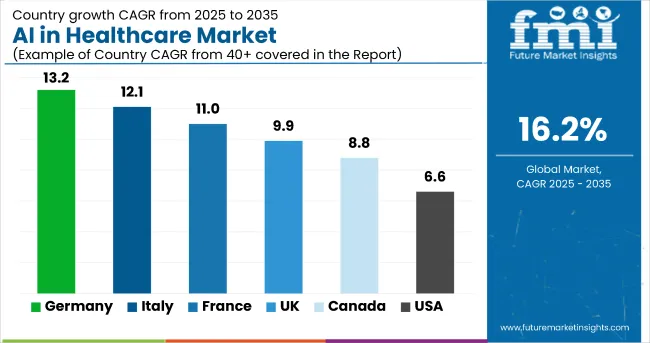
| Countries | Value CAGR (2025 to 2035) |
|---|---|
| USA | 6.6% |
| Canada | 8.8% |
| Germany | 13.2% |
| France | 11.0% |
| Italy | 12.1% |
| UK | 9.9% |
| Spain | 9.3% |
| China | 17.1% |
The United States’ healthcare system is highly advanced. As the chronic disease prevalence is increasing the pressure created on the healthcare system in immense. There is need for accurate and faster diagnostic solution. AI technologies are addressing these challenges by significantly enhancing diagnostic imaging solutions.
AI algorithms based on deep learning and neural networks can analyze medical images. Arterys, Zebra Medical Vision, and Aidoc are developing AI solutions that can automatically detect medical conditions. These solution can classify among the various disease conditions such as cancers, cardiovascular diseases etc. AI tools can process vast amounts of imaging data in a fraction of the time.
The United States has become a global hub for AI research. Major tech companies are heavily investing in AI solutions. Additionally, regulatory agencies such as the FDA are increasingly approving AI-based medical devices. Hence due to the joint effect of private sector and support environment by the government bodies the artificial intelligence in healthcare industry is growing within the United States.
Germany has strong focus on precision medicine. Precision medicine refers to tailoring medical treatment to individual characteristics. Precision medicine rely on analyzing vast among of patient data. AI is crucial to analyze large datasets from diverse sources such as genomic data, electronic health records (EHRs), and clinical trials.
New pattern are uncovered while analyzing the patient data which allows to predict most effective treatment option. AI algorithms are used to interpret genetic data offering personalize treatments for complex diseases. Companies like BioNTech are leveraging AI to analyze genetic information to create targeted therapies. The main advantage of targeted therapy is that it results in lower side effects.
The government has been proactive in creating a framework to digitize healthcare processes. This initiative promote the use of AI across the healthcare system. AI can be integrated into electronic health records (EHR) to enhance decision support systems which ultimately ensure better interoperability between healthcare platforms. The focus on utilizing AI for precision medicine is fueling the industry growth in Germany.
Japan is a global leader in robotics. The continuous robotic innovations is transforming healthcare delivery, making it more efficient and patient-centric. Using AI enhance surgical precision by minimize human error. AI algorithms in robotic surgery platforms like Fujifilm’s Endoscope Robotics assist in real-time decision-making to guide surgeons on complex procedures.
Japan has higher percentage of elderly population that requires more frequent surgeries. AI-driven robots led to reduced trauma and improved patient outcomes. Additionally, Japan’s aging population has spurred the development of care robots like Robear and Pepper. This robots assist with tasks such as lifting, moving, and monitoring elderly patients.
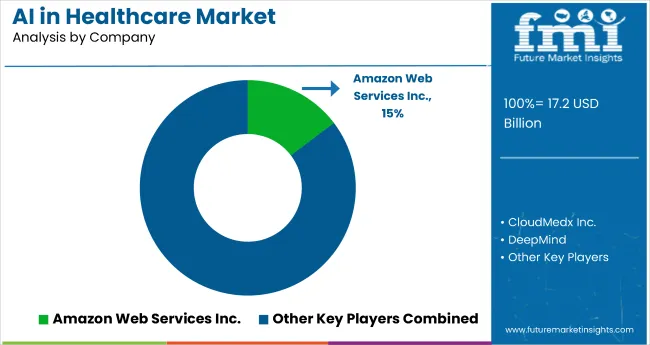
Market players are developing new artificial intelligence (AI) Model to address various gaps within the healthcare industry. It can analyzing molecular structure of compound, accelerating the drug discovery, increasing accuracy in diagnosis, improving the operational efficiency etc.
Firms are collaboration to leverage each other technical capability and achieve greater milestone. Industry leader are also acting as catalyst in implementation of AI within various healthcare domains by provide grants, funding for Institutions providing value within the industry using AI. This market dynamic act as a breeding ground for future innovations.
| Report Attributes | Details |
|---|---|
| Current Total Market Size (2025) | USD 17.2 billion |
| Projected Market Size (2035) | USD 77.2 billion |
| CAGR (2025 to 2035) | 16.2% |
| Base Year for Estimation | 2024 |
| Historical Period | 2020 to 2024 |
| Projections Period | 2025 to 2035 |
| Quantitative Units | Revenue in USD billion |
| Offering Segments | Hardware, Software, Services |
| Technology Segments | Machine Learning, Context-Aware Computing, NLP, Deep Learning, Querying Method, Others |
| Application Segments | Robot-Assisted Surgery, Virtual Nursing Assistant, Admin Workflow Assistance, Fraud Detection, Dosage Error Reduction, Clinical Trial Participant Identifier, Preliminary Diagnosis, Others |
| End Users | Healthcare Providers, Pharmaceutical and Biotech Companies, Patients, Others |
| Regions Covered | North America, Latin America, Western Europe, Eastern Europe, South Asia & Pacific, East Asia, Middle East & Africa |
| Countries Covered | USA, Canada, Germany, France, Italy, UK, Spain, China, India, Japan |
| Key Players | Amazon Web Services, Microsoft Corporation, Nvidia Corporation, Intel Corporation, Siemens Healthcare, DeepMind, Medtronic, Nuance Communications, Micron Technology |
| Additional Attributes | Semi-annual CAGR, Segment-wise Market Share, Country-wise Growth Rates, Tier-wise Company Market Share |
| Customization and Pricing | Available upon request |
In terms of offering, the industry is segmented into hardware, software, and services.
In terms of technology, the industry is machine learning, context-aware computing, natural language processing, deep learning, querying method, and others.
In terms of application, the industry is segmented into robot-assisted surgery, virtual nursing assistant, administrative workflow assistance, fraud detection, dosage error reduction, clinical trial participant identifier, preliminary diagnosis, and others.
In terms of end user, the industry is segmented into healthcare providers, pharmaceutical and biotechnology companies, patients, and others.
Key countries of North America, Latin America, Western Europe, Eastern Europe, South Asia and Pacific, East Asia, the Middle East, and Africa have been covered in the report.
As of 2025, the Artificial Intelligence in Healthcare Market is valued at USD 17.2 billion and is projected to reach USD 77.2 billion by 2035, growing at a CAGR of 16.2%.
Key technologies fueling the Artificial Intelligence in Healthcare Market include machine learning, natural language processing, deep learning, context-aware computing, and querying methods, with machine learning leading due to its versatility in clinical applications.
Major end users in the Artificial Intelligence in Healthcare Market include healthcare providers, pharmaceutical and biotechnology companies, patients, and other healthcare institutions integrating AI for diagnostics, treatment, and operational efficiency.
In the Artificial Intelligence in Healthcare Market, primary applications include robot-assisted surgery, virtual nursing assistants, administrative workflow automation, fraud detection, dosage error reduction, and clinical trial participant identification.
East Asia and South Asia & Pacific are expected to witness the fastest growth in the Artificial Intelligence in Healthcare Market between 2025 and 2035, driven by digital healthcare initiatives and rising AI adoption in diagnostics and patient care.






Our Research Products

The "Full Research Suite" delivers actionable market intel, deep dives on markets or technologies, so clients act faster, cut risk, and unlock growth.

The Leaderboard benchmarks and ranks top vendors, classifying them as Established Leaders, Leading Challengers, or Disruptors & Challengers.

Locates where complements amplify value and substitutes erode it, forecasting net impact by horizon

We deliver granular, decision-grade intel: market sizing, 5-year forecasts, pricing, adoption, usage, revenue, and operational KPIs—plus competitor tracking, regulation, and value chains—across 60 countries broadly.

Spot the shifts before they hit your P&L. We track inflection points, adoption curves, pricing moves, and ecosystem plays to show where demand is heading, why it is changing, and what to do next across high-growth markets and disruptive tech

Real-time reads of user behavior. We track shifting priorities, perceptions of today’s and next-gen services, and provider experience, then pace how fast tech moves from trial to adoption, blending buyer, consumer, and channel inputs with social signals (#WhySwitch, #UX).

Partner with our analyst team to build a custom report designed around your business priorities. From analysing market trends to assessing competitors or crafting bespoke datasets, we tailor insights to your needs.
Supplier Intelligence
Discovery & Profiling
Capacity & Footprint
Performance & Risk
Compliance & Governance
Commercial Readiness
Who Supplies Whom
Scorecards & Shortlists
Playbooks & Docs
Category Intelligence
Definition & Scope
Demand & Use Cases
Cost Drivers
Market Structure
Supply Chain Map
Trade & Policy
Operating Norms
Deliverables
Buyer Intelligence
Account Basics
Spend & Scope
Procurement Model
Vendor Requirements
Terms & Policies
Entry Strategy
Pain Points & Triggers
Outputs
Pricing Analysis
Benchmarks
Trends
Should-Cost
Indexation
Landed Cost
Commercial Terms
Deliverables
Brand Analysis
Positioning & Value Prop
Share & Presence
Customer Evidence
Go-to-Market
Digital & Reputation
Compliance & Trust
KPIs & Gaps
Outputs
Full Research Suite comprises of:
Market outlook & trends analysis
Interviews & case studies
Strategic recommendations
Vendor profiles & capabilities analysis
5-year forecasts
8 regions and 60+ country-level data splits
Market segment data splits
12 months of continuous data updates
DELIVERED AS:
PDF EXCEL ONLINE
Artificial Intelligence (chipset) Market Forecast and Outlook 2025 to 2035
Artificial Intelligence in Construction Market Size and Share Forecast Outlook 2025 to 2035
Artificial Intelligence in Telecommunication Market Size and Share Forecast Outlook 2025 to 2035
Artificial Intelligence in Retail Market Size and Share Forecast Outlook 2025 to 2035
Artificial Intelligence (AI) in Automotive Market Size and Share Forecast Outlook 2025 to 2035
Artificial Intelligence In Cybersecurity Market Size and Share Forecast Outlook 2025 to 2035
Artificial Intelligence in Military Market Analysis - Size & Forecast 2025 to 2035
AI Systems Spending Market Report – Growth & Forecast 2017-2027
Healthcare Business Intelligence Market Size and Share Forecast Outlook 2025 to 2035
Artificial Ear Simulator Market Size and Share Forecast Outlook 2025 to 2035
Healthcare Air Purifier Market Size and Share Forecast Outlook 2025 to 2035
Healthcare Regulatory Affairs Outsourcing Market Size and Share Forecast Outlook 2025 to 2035
Healthcare and Laboratory Label Industry Analysis in the United States Size and Share Forecast Outlook 2025 to 2035
Healthcare Flooring Market Size and Share Forecast Outlook 2025 to 2035
Healthcare AI Computer Vision Market Size and Share Forecast Outlook 2025 to 2035
Artificial Insemination Market Size and Share Forecast Outlook 2025 to 2035
Healthcare Master Data Management Market Size and Share Forecast Outlook 2025 to 2035
Intelligence Surveillance Reconnaissance (ISR) Market Size and Share Forecast Outlook 2025 to 2035
Artificial Tears Market Size and Share Forecast Outlook 2025 to 2035
Healthcare and Laboratory Label Industry Analysis in Japan Size and Share Forecast Outlook 2025 to 2035

Thank you!
You will receive an email from our Business Development Manager. Please be sure to check your SPAM/JUNK folder too.
Chat With
MaRIA